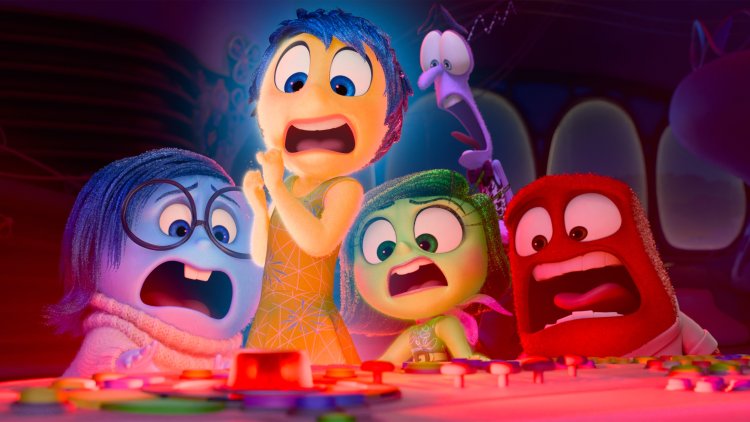What the Success of <em>Inside Out 2</em> Means for Hollywood
The movie industry is still recovering from 2023’s dual strike, but there are clear signs of life.

The big new character in Pixar’s Inside Out 2 is Anxiety, which makes sense, given how much pressure was being loaded onto the film before its release. In a Time feature, Pixar’s creative head, Pete Docter, candidly admitted as much: “If this doesn’t do well at the theater, I think it just means we’re going to have to think even more radically about how we run our business.” Hollywood at large—the executives, producers, financiers, and other assorted figures whose feelings affect which movies get made, and for what reasons—was similarly biting its fingernails, after years of post-COVID anticipation for movies to be fully and simply “back.” Following the underwhelming performances of big-budgeted 2024 releases such as The Fall Guy and Furiosa, panic was growing that audiences had lost interest in seeing anything at the theater, even from a brand as previously recession-proof as Pixar.
Everyone needn’t have worried. Inside Out 2 opened to $155 million, almost doubling industry expectations and posting the second-highest opening of all time for an animated movie. Last weekend, it made $101 million, the highest second weekend for an animated movie ever, and even higher than the second weekend of 2023’s biggest box-office phenomenon, Barbie. Surely now Anxiety can be packed away—and the sunny Joy, another Inside Out character, can become the box office’s summer mascot. But why was everyone so anxious in the first place?
The waves of worry emanating from the industry—through columns by insiders, off-the-record hand-wringing by executives, and the like—only sometimes acknowledged that 2024 was going to be an awkward bridge year for films. The long dual writer and actor strikes of 2023 gummed up production for countless movies, causing numerous delays—which, bluntly, meant that fewer finished products were ready for release this year. That placed even more expectations on big blockbusters to succeed so that chains such as AMC and Regal would stay afloat before the release schedule rebounded in 2025.
But here’s the thing: Those movies are coming, just not this year. In general, studios are pivoting back to releasing their movies in theaters, given that the straight-to-streaming approach never generated much in terms of profit (unless you’re Netflix). One reason studios are pivoting is that, last year, movies such as Barbie and Oppenheimer proved that audiences of all demographics would flock to films that weren’t just franchise sequels, and that people were still excited about the communal moviegoing experience. Last July, I wrote that Hollywood was catastrophically fumbling the accomplishment of those movies by playing hardball with the writers’ and actors’ unions (and eventually losing), and this mediocre 2024 release calendar is the result. But it’s not permanent.
Yes, something as visually dazzling as Furiosa should have performed better, at least in the eyes of critics like me. Still, it’s clear that audiences just weren’t that intrigued by a prequel to a nine-year-old film in a series that’s always had niche commercial appeal. The Fall Guy, a goofy, self-referential comedy about a stuntman on a film set, has made about $90 million domestically, which is solid—but the movie was crushed under expectations stemming from its budget. At a slightly smaller scale, it would have invited less scrutiny and possibly done just as well.
The year in film has, in fact, had plenty of hits. Dune: Part Two was an out-and-out smash. Grown-up dramas such as Civil War and Challengers generated major buzz and ticket sales; franchise movies such as Godzilla x Kong, Kingdom of the Planet of the Apes, and Bad Boys: Ride or Die all played to expectations. But the industry definitely needed a movie to massively outperform all predictions—and Inside Out 2 is that winner, reassuring Hollywood that families (once the most reliable audience of all) are still willing to flood multiplexes for the right film.
[Read: How Pixar lost its way]
That brings us to Pixar, which was somewhat pilloried following a recent Bloomberg feature that said the company would be prioritizing sequels, following a string of commercial flops. But things were never so unexplainably dire for the studio. Although Pixar has largely put out original films of late—Soul, Luca, Turning Red, and Elemental among them—only Elemental was given a theatrical release, because of concerns over audience willingness to risk getting COVID-19 and a desire to pump up Disney+’s subscriber numbers. Meanwhile, Lightyear, a misguided spin-off of the Toy Story franchise, was pushed to theaters, where it was financially disappointing. Elemental started slow but became a sleeper success, suggesting that a reliance on old glories might actually be foolish.
The massive triumph of Inside Out 2 will rebut that thinking. On top of the already-announced Toy Story 5, Bloomberg reported that new Incredibles and Finding Nemo entries may soon find their way to the top of Pixar’s development slate. But the success of Inside Out 2 is also good news for Pixar in that making money will ease the pressure on its creative teams. Yes, they’ll make more sequels, but people such as Pete Docter know that new ideas have to flourish to keep the company moving forward—just as theatrical hits only help build out the streaming catalogs Disney wants people to sign up for.
As Docter put it to Time, a rising tide lifts all boats: “The better [a movie] does at the theater, the more successful it has been on Disney+. Initially you’d think if it does really well in the theater, nobody’s going to watch it on Disney+ because we’ve seen it already. It’s actually the opposite.” Although he was talking about Pixar, it’s a lesson that Hollywood needs to internalize from this summer, as it tries to hope that brighter times are ahead.
What's Your Reaction?




















